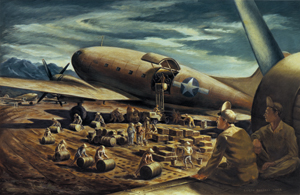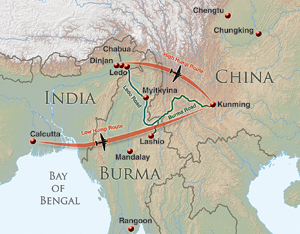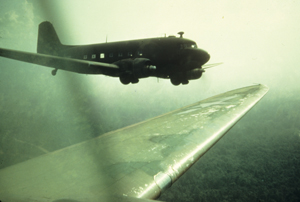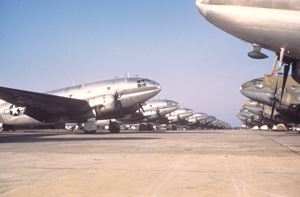When the Chinese capital city of Nanking fell in December, Chiang Kai-shek and the Nationalist goverment retreated, first to Hankow and then, in October 1938, to Chungking, which became the wartime capital of unoccupied China.
 |
Kunming, China, depicted in this 1945 painting by Loren Russell Fisher, had been a resort town in the mountains, but became one of the busiest airports in the world as the main terminus for supplies shipped over the Hump. |
Japanese forces held all important points in eastern China, including cities, railways, rivers, and ports. From 1937 to 1941, Nationalist China was resupplied from Russian Turkestan, with the goods passing through Sinkiang on the ancient Silk Road. That route, however, was closed down when the Soviet Union signed a nonaggression pact with Japan in April 1941.
Chiang’s only remaining way to obtain strategic supplies from the outside world was through British-controlled Burma. War materiel and munitions passed from the port at Rangoon to the railhead at Lashio. There began the Burma Road, winding about 700 arduous miles across the Himalaya Mountains to Kunming.
To get over the high passes, trucks took a perilous course. Drivers had to negotiate several miles of hairpin turns for every mile of forward progress. Protecting the Burma Road was one of the main reasons China had recruited Claire L. Chennault and his American Volunteer Group, the renowned Flying Tigers.
Then, in January 1942, Japanese forces invaded Burma, and, within months, forced the British Army back to India. The British forces were able to hold at the border, and Chinese troops stopped the invaders on the Burmese side of the Salween River gorge, thanks in considerable part to the Flying Tigers. However, the overland supply route through Burma was cut off.
The US was determined to keep China in the war, and the only way to supply Chiang’s army and Chennault’s China Air Task Force was by air, across the “Hump” of the towering Himalayas.
US Tenth Air Force in India, ordered to initiate the airlift, was plunged into the unknown in more ways than one. That is because, before the start of the war, the Army Air Corps had never put together an organized airlift function.
The Air Corps’ Ferrying Command was created in 1941 and became Air Transport Command in 1942, but ATC reported to the War Department, not to theater commanders. There was no precedent for what was about to happen.
Air routes over the mountains had been explored by China National Aviation Corp., owned jointly by Pan American World Airways and the Chinese government, but these routes were not in regular use. Aeronautical charts were unreliable and weather information was virtually nil.
The transports had to cross one mountain chain after another. The passes were 14,000 feet high, flanked by peaks rising to 16,500 feet. Elevations were lower at the southern end—the so-called “Low Hump”—but patrols by Japanese fighters forced most flights farther north until late in the war.
The main Hump, which gave its name to the entire route across the mountains, was the 15,000-foot Sansung range between the Salween and Mekong rivers. From bases in India, it was 500 miles across the Hump to China. Flying time was four to six hours, depending on the weather.
“Winds of as much as 100 miles an hour, piling into the steep barren slopes, would glance off to create updrafts over the ridges, downdrafts over the valleys,” said William H. Tunner, as a brigadier general the last commander of the Hump airlift. “Planes caught in a downdraft could drop at the rate of 5,000 feet per minute, then suddenly be whisked upward at almost the same speed.”
Turbulence could flip an airplane over on its back. Icing was a problem above 12,000 feet, and wings were sometimes bent or warped from the buildup.
It was an exceptionally dangerous place to fly. Hundreds of airplanes went down in the mountains or in the thick jungles that lay on either side. An “aluminum trail” marked crash sites over the mountains. With spare parts in short supply, teams were often sent into the foothills to recover what they could. The accidents spawned a craft industry among the mountain villagers, who produced aluminum artifacts from the crash site debris.
 |
The Low Hump route over the southern end of the range was less perilous, but Japanese fighters forced most missions over the main Hump—including the 15,000-foot-high Sansung range between the Salween and Mekong rivers. |
Over this forbidding mountain mass, “every vehicle, every gallon of fuel, every weapon, every round of ammunition, every typewriter, and every ream of paper which found its way to Free China for either the Chinese or the American forces during nearly three years of war was flown in by air from India,” the official Army Air Forces history of the war said.
Regular operations over the Hump began in May 1942 with 27 aircraft. These were mostly Douglas DC-3 airliners converted to C-47s, the military configuration which had stronger floors and larger doors.
An early commander complained that the C-47’s altitude limitations made it “entirely unsuitable” for flying the Hump, but the C-47 was famous for exceeding performance specifications. One C-47 is on record as hauling a full load over the Hump at 24,000 feet.
Initially, few supplies landed at the port of Calcutta, which was menaced by the Japanese. Most cargo bound for China came into Bombay or Karachi on the west coast of India and went cross country from there. At first, Tenth Air Force airlift flights originated in Karachi and staged for the Hump leg of their mission though Dinjan, a British base on the flood plain of the Brahamaputra River in the upper Assam Valley.
When the port of Calcutta came into greater use, the airplanes and crews transferred to Dinjan and other bases in Assam, but that introduced a new problem. Every Indian state used a different gauge of track for its railroad, so the cargo had to be unloaded and reloaded at several points on the 600-mile trip from Calcutta north to Assam.
The Fireball Express
Grandiose expectations for the airlift—and promises made by the politicians to the Chinese—were at odds with the meager resources provided. A lack of engines and spare parts meant there were seldom more than 18 airplanes available to fly the Hump.
Chiang Kai-shek clamored for the airlift to fly 10,000 tons a month. The officially stated US goal was 4,000 tons. In practice, Tenth Air Force was unable to haul more than a few hundred tons a month.
Gen. Henry H. “Hap” Arnold, commander of the AAF and never a patient man, recognized the problems but felt that Tenth Air Force should have done better anyway. He transferred responsibility to Air Transport Command, which took over in December 1942.
Monthly tonnage built gradually as more and larger transports joined the Hump operation. In January 1943, the first four-engine C-87s—B-24 bombers converted into transports—arrived to supplement the C-47s. The C-87s could fly higher and faster and carry more cargo, but they were beset with maintenance problems, leaky fuel tanks, and a vulnerability to icing.
Heavier weights at takeoff and landing added to the difficulties. The C-87 and its tanker variant, the C-109, experienced accidents at five times the rate of other transports on the route. Pilots, wary of the high-octane cargo, called the C-109 the “C-One-Oh-Boom.” Some B-24s in the original bomber configuration were pressed into service to carry aviation gas and supplies as well.
The workhorse of the Hump airlift, the Curtiss C-46, arrived in April 1943. It was the largest twin-engine aircraft built to that point. The C-46 was more temperamental to fly than the beloved C-47, but its excellent visibility, big doors, and large cargo capacity compensated for its faults.
In May 1943, when deliveries had at last surpassed 2,000 tons a month, President Roosevelt abruptly raised the goal to 7,000 tons by July and 10,000 tons by September. ATC’s India-China wing met that goal in December 1943—actual tonnage that month was 12,590—for which it received a Presidential Unit Citation.
The “Fireball Express” began in September 1943, with C-87s making weekly runs to India with spare parts from the Air Service Command depot in Fairfield, Ohio. The camouflage paint was stripped off the airplanes to give them an extra 5 mph of airspeed.
 |
A US C-47 flies over Burma in 1945. The massive undertaking to supply China during World War II defined a new mission for USAF—critical airlift. |
The airlift ultimately operated from 13 bases in India. There were six bases in China with the main terminus at Kunming, which became one of the busiest airports in the world. Kunming, which had been a resort town in the mountains, was cooler than Assam and the food was better.
Conditions at all of the bases in Assam were primitive. Crews lived in tents and bamboo huts, with pythons and other creatures making frequent visits. Jeeps sped down the runways ahead of airplanes taking off to clear cows and local citizens out of the way. Clothing and shoes mildewed in a few days from the humidity. The heat was oppressive and the rains were heavy. At one point in 1942, the water was nine inches deep on the airstrip at Dinjan.
At Chabua, the Assam Valley floor was 90 feet above sea level, but the mountains to the east rose quickly to 10,000 feet. After takeoff, pilots circled the aerodrome twice to gain altitude. “Flying from Chabua was like flying out of a hole in the mountains,” said Otha C. Spencer who flew the Hump and wrote a book about his experiences.
In China, the aircrews could get milk and fresh eggs, even fried chicken and steak, all of which were luxury fare in Assam, where the mess halls served Spam and K-rations. Spencer recounts the story of a B-24 pilot based at Chengkung who carried 24 dozen eggs along on a flight to Chabua, where he traded them for an unused piano in the mess hall. He loaded the piano on his airplane and took it back to his squadron in China.
The most critical commodity delivered by the airlift was 100-octane aviation gasoline, typically carried in 55-gallon drums. Elephants were trained to lift the gasoline drums to the cargo door of the airplanes, with one elephant doing the work of a dozen laborers.
In flight, the gasoline drums often sprung leaks with changes in the atmospheric pressure and had to be wrestled out the door by the crew. If a drum broke loose from its bindings in heavy turbulence, a pilot could count himself fortunate to land with no more than a few dents in the roof of the cabin.
In the last years of the war, much of the gasoline was carried by tanker aircraft. By 1945, gasoline and oil accounted for nearly 60 percent of the tonnage flown eastward over the Hump.
The airlift brought about 3,000 mules over the Hump, mostly for the Chinese army. They rode four mules to a transport, with four Chinese “cowboys” keeping them under control. Crew members said it took a day to clear the smell out of the airplanes.
Into the Weather
The most unusual cargo may have been bales of Chinese paper money, printed by the American Note Co. and delivered by Hump transports.
With more and better transports on the job, 1944 saw a surge in deliveries to the China bases. By the end of the year, 250 aircraft were operating over the Hump, four times the number flying the route the previous year. Each C-46, now the dominant airlifter in the fleet, carried twice as much cargo as a C-47.
Considerable credit for the increase is accorded to Col. Thomas O. Hardin, a hard-charging former airline executive, who had taken command of the airlift in September 1943.
Hardin ordered a bolder approach to operations. Missions would be flown as scheduled, without regard to storms over the Hump, reports of enemy aircraft, or whether a transport fully met tech order specifications. He also began night flights over the Hump. Between September 1943 and August 1944, Hardin forced Hump deliveries up from 4,624 tons a month to 23,675 tons. When the India-China Wing of ATC became a division, Hardin was promoted to brigadier general and put in command.
Losses rose as well. Japanese fighters were a threat, but accidents took a heavy toll.
Between June and December 1943, there were 155 major accidents on the Hump route, with 168 crew fatalities.
Air patrols searched the jungles of Burma and China for aircraft wreckage. Light aircraft brought out survivors, medics parachuted in when needed, and supplies were air-dropped to crews able to walk out.
Hump aircrews wore “blood chits” made of leather or silk inside their flying jackets. These colorful patches, about 8 by 10 inches, promised a reward to villagers and tribesmen who took downed aviators to the nearest US base. Blood chits were introduced in China by the Flying Tigers, who wore them outside, on the backs of their jackets, but chits made good targets for snipers, so Hump pilots sewed them on the inside.
Just as Hardin was getting the tonnage up, a major new customer arrived. In the spring of 1944, Operation Matterhorn brought B-29 bombers to India. From there, they staged through forward bases in China to fly bombing missions that reached as far as the southernmost Japanese home islands. This required the pre-positioning of supplies, particularly fuel, at the B-29 bases around Chengtu in China. XX Bomber Command, which flew the missions, carried a substantial amount of its own cargo to the forward bases and converted some of its B-29s to tankers to haul aviation gas. Even so, 12 percent of the ATC tonnage flown over the Hump was to support the B-29s before Operation Matterhorn ended in 1945.
A number of other units flew Hump missions, too. Foremost among them was China National Aviation Corp., the organization that had first explored routes over the Himalayas. In 1944, CNAC delivered 41,000 tons of cargo to supplement the 230,000 tons flown in by Air Transport Command.
The most famous commander of the Hump airlift, Tunner, took over from Hardin in September 1944. Tunner wrote in his memoirs that the orders from ATC were “to continue the increase in tonnage but at less cost in American lives” and to improve morale in the India-China Division, which was “none too good.”
His first order was to cancel Hardin’s policy that forced pilots to fly regardless of weather. Tunner emphasized regularity, standardization, procedure, and safety. He was dubbed “Willie the Whip” for the discipline he imposed.
Tunner also enforced military standards of personal appearance, which had slipped badly. This was unpopular at first, but morale rose, especially as food and living conditions improved. Tonnage over the Hump continued to increase—reaching 53,315 tons in July 1945—and the accident rate dropped to one-seventh its previous rate.
 |
This lineup of C-46 aircraft on the ramp at Ondal, India, was destined for China’s Nationalist Air Force—a gift from the US. |
A Major New Mission
Tunner’s success was due in part to the actions he took, but several other developments gave him a huge boost. In May 1944, the Allies recaptured Myitkyina, the main base in Burma from which Japanese fighters threatened the Hump. This made it possible for Tunner’s aircraft to use the Low Hump route in the south.
Using Myitkyina as a halfway station, the airlifters were able to increase deliveries to China.
The last of the major Hump transports, the four-engine Douglas C-54, joined the operation in October 1944. The C-54 could not be used on the northern route because of altitude limitations, but it was ideal for the more benign southern route, where elevations were 12,000 feet or lower.
The C-54s were based in Calcutta and had sufficient range to fly directly to China, which eliminated the need to shuttle cargo by rail from the port to the upcountry bases.
By July 1945, Tunner had on average 332 airplanes a day operating over the Hump, a far cry from the hard-pressed 62 on the route in January 1943. He would have liked to replace the accident-prone C-87s altogether with C-54s but was unable to obtain enough. In fact, additional B-24s, no longer needed in their primary bombing mission, were assigned as cargo haulers to augment the Hump transport fleet.
Meanwhile, the Allies had finally established an overland route into China. This was the Ledo Road, begun in 1942 and finished in January 1945.
The Ledo Road ran 465 miles from Ledo in Assam to link up with old Burma Road north of Lashio near the Chinese border. The first convoy of 113 vehicles reached Kunming, 1,100 miles from the starting point, Feb. 4, 1945.
Over the next seven months, 35,000 tons of supplies moved over the Burma Road in 5,000 vehicles. Still, the transports brought more than that every month.
The Hump operation was officially closed Nov. 15, after the war had ended.
In all, the Hump airlift had carried 650,000 tons of gasoline, supplies, and men to China, more than half of that total in the first nine months of 1945. The results had come at a great price. During the operation, 509 aircraft from Air Transport Command and other organizations were lost. The total of crew members known dead was 1,314, with 345 listed as missing. Almost 1,200 had been rescued or walked out to safety.
The search for aircrew remains continues. Earlier this year, a recovery team from the Joint POW/MIA Accounting Command reached a remote site in India where a B-24J went down Jan. 25, 1944.
The airlift over the Hump succeeded in its main objective. China was able to remain in the war, thanks to the airlift and American airpower, which the airlift supported. Allied operations held off the Japanese, kept pressure on Japan from another front, and tied up a large enemy force on the Asian continent.
Beyond that, the flights over the Hump established airlift as a major new Air Force mission. ATC evolved into Military Air Transport Service, then Military Airlift Command, and finally today’s Air Mobility Command.
The Hump set the model for large-scale aerial supply and sustainment operations from the Berlin Airlift in 1948-49—which Tunner, by then a two-star general, was called in to command—the Yom Kippur airlift to Israel in 1973, and the massive airlift that supported the Gulf War in 1990 and 1991.